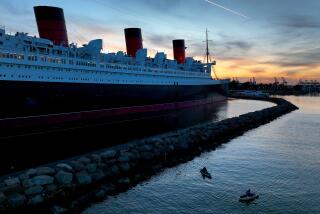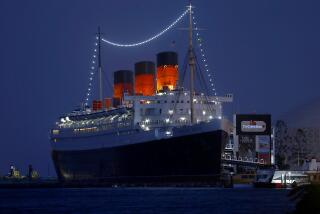How Ships Score in Sanitation Rating System
- Share via
Tom Hunt believes he is a lot safer eating on board a cruise ship than in a restaurant.
The Miami-based Hunt, who is chief of the vessel sanitation program for the U.S. Public Health Service, is head of a six-man team that inspects and grades the kitchens, water systems and food storage areas of cruise ships.
“I’ve inspected a lot of land-based restaurants over the years,” said Hunt, who began his career as a restaurant inspector in Salt Lake City. “If I would compare our worst ship to any land-based restaurant, our ships are better.”
The findings of Hunt’s team are published in a mailing popularly called “the green sheet,” which is sent to travel agents, newspapers, magazines and cruise-industry personnel every two weeks.
What they are checking on cruise ships, according to Hunt, is first and most important the safety of the water supply; second, how long food is held at certain temperatures that could be unsafe, such as on decks and at midnight buffets.
“If the ship’s staff throws the food out there and it sits at room temperature for three or four hours, there’s going to be a disaster,” Hunt said.
Hunt, who took over the ship inspection post in February, 1989, has helped initiate a new scoring system to replace the one that rated vessels only “satisfactory” or “unsatisfactory,” depending on whether they received more or less than 86 points on a scale of 100.
Now the actual numerical grades are published. Hunt thinks the change makes cruise lines much more sensitive to their scores than they were under the previous system.
“An 84 and a 30 are both failing, but in different degrees,” he said. As for those that pass: “It’s no longer sufficient for them to get an 86. They want a 90-plus.”
For the first time ever, two ships have scored 100 on 1990 inspections--Carnival Cruise Lines’ Fantasy on its inspection of April 30, coming up from an initial failing grade of 78, and Windstar Cruises’ Wind Spirit on its Aug. 27 inspection.
The Wind Spirit’s earlier ratings were 94 and 88, both passing. On a subsequent inspection Aug. 24, Fantasy slipped back to an 88.
The ratio of passing and failing has changed dramatically since the numerical system and a new, easier-to-understand manual were introduced.
In addition, Hunt’s emphasis on education and his new series of training classes to teach kitchen supervisors and chefs about food handling and water treatment--in effect telling them not only what the Public Health Service wants but why it wants it--have made a discernable improvement in ship sanitation.
On the Oct. 28, 1988, report, 43 ships passed and 36 failed. A year later, 64 passed and 24 failed.
The most recent report--Oct. 26, 1990--shows that 83 passed and 18 failed. (The total number on each report vary, depending on how many ships are in service and how many have been inspected.)
Hunt and his team performed 200 ship inspections in 1989 and will do about 255 by the end of 1990. In 1988, under the old system, about 130 ships were inspected.
The current failing ships and their scores, from low to high, are:
Vistamar, 30; Odysseus, 50; Berlin, 56; Pride of Mississippi, 57; Vasco de Gama (not in service at the present time), 58; Pegasus, 62; Polaris, 66; Society Explorer, 66; Ocean Spirit (not in service), 68; Fair Princess, 76; Crystal Harmony, 77; Cunard Countess, 78; Daphne, 78; New Shoreham II, 80; Seabourn Pride, 80; Britanis, 82; EugenioCosta, 83, and Scandinavian Sun, 83.
The highest scorers on the current green sheet are:
Wind Spirit, 100; Royal Viking Star, 99; Americana, 98; Amerikanis, 97; Crown Odyssey, 97; Royal Viking Sky, 97; Starship Oceanic, 97; Holiday, 96; Song of America, 96; Vistafjord, 96; Sagafjord, 95; Sea Goddess I, 95; Azure Seas, 94; Seabourn Spirit, 94, and Seaward 94.
The foreign-flag ships now understand what the Public Health Service wants, according to Hunt. “That’s the key, since we’re judging them consistently each time. We want each inspector to come in with the same criteria.”
One story from earlier days, perhaps true, Hunt said, is about an inspector who came aboard a ship and demanded that the ice machine be moved across the room from one spot to another, which the bewildered staff did. On the next inspection a year or so later, another inspector took one look at the ice machine and ordered it moved back to where it had been originally.
“So we’ve put out a good manual,” Hunt said. “When the inspectors go on board, we not only tell them this is wrong, but why it’s wrong.” Hunt believes education is one of the most important aspects of his job.
The ships that Hunt inspects carry 13 passengers or more and have an international itinerary. This includes excursion-type ships with one-day sailings outside U.S. waters so passengers can gamble--vessels such as the Viking Princess and the SeaEscape ships that sail from Florida.
It does not, however, include U.S. flag ships that do not leave U.S. waters, such as the Delta Queen and Mississippi Queen paddle-wheelers, which sail the Mississippi River, and American Hawaii’s two cruise ships that sail entirely within Hawaii. Inspections of these ships are the responsibility of the states they sail in and the U.S. Food and Drug Administration.
Hunt and his team also do construction inspections on new vessels in the shipyards, financed by the yards and cruise companies “because they really want to know so they can take care of any problems at the yard before the ship sails for the first time.”
Periodic health inspections on ships are paid for by the cruise lines as well.
The Centers for Disease Control inspects ships only in U.S. ports, such as Miami, Fort Lauderdale, Port Canaveral, Key West, New York City, St. Thomas, San Juan, New Orleans, Galveston, San Diego, Los Angeles and several ports in Alaska.
Hunt was recently in Guam for the first time, making a construction inspection follow-up on Salen Lindblad’s new Frontier Spirit before its maiden voyage.
“Normally I wouldn’t come to Guam,” Hunt said, “but the vessel will not be inspected in the United States prior to its first dry dock, and they wanted to be able to make any necessary changes then before their first grade score.”
The cruise lines have been completely cooperative, Hunt said, despite the fact that the Public Health Service has no legislative authority to implement sanctions against foreign-flag vessels.
“I’m just making recommendations,” Hunt said. “I can’t keep a ship from sailing.”
At the same time, he emphasized, cruise lines are all too aware of the publicity that major outbreaks of food- or water-borne illnesses on a cruise ship would get, especially if 300 to 400 people got sick.
“Cruise lines want their passengers to have a good experience and to come back again,” Hunt said, “so they pay attention to their scores.”
Potential passengers should understand that a failing grade does not mean a diarrheal outbreak is impending, nor does a passing score mean a traveler can suspend normal precautions with impunity. The grades only indicate the condition of the vessel on the date of inspection.
Detailed inspection reports on individual vessels will be sent free on request. Write Chief, Vessel Sanitation Program, Center for Environmental Health and Injury Control, 1015 North America Way, Room 107, Miami, Fla. 33132.
More to Read
Sign up for The Wild
We’ll help you find the best places to hike, bike and run, as well as the perfect silent spots for meditation and yoga.
You may occasionally receive promotional content from the Los Angeles Times.






